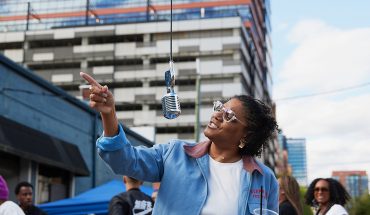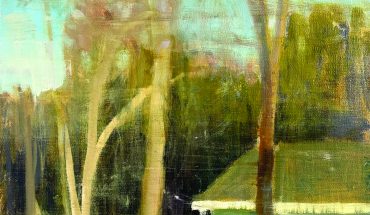
by Scott Huler
The dozen or so healthy oak trees standing in a line in the secret park along the Pigeon House Branch north of Peace Street look to be about 40 years old, which means the oaks, which you almost certainly have never seen, were probably planted right when the city tore down the old ballpark.
Wait a minute: Ballpark? Pigeon House Branch? Secret park?
Yes—to all three. Welcome to a part of Raleigh, past and present, you either have never heard of or have completely ignored. Ride your bike, or walk, or—all right—drive to the lowest spot on Peace Street, down the hill east of Glenwood. The Pigeon House Branch, Raleigh’s dirtiest stream, drains through Cameron Park, veers into tunnels beneath the streets of downtown, and emerges from under Peace to continue its way to Crabtree Creek. For a while it flows along in a lovely, stone-sided culvert lined by scrub brush and scrawled with interesting graffiti. The creek briefly goes back underground, covered by stone pavers that run down a long strip of green that includes grass, those sentinel oaks, and even a couple of horseshoe pits. And, if you look closely, on a wall made of the same stone that lines the culverts, the plumbing remnants of at least one toilet.
Which, once upon a time, would have been in a restroom under the right field bleachers at the old Devereux Meadow ballpark, where the Raleigh Capitals played Class B baseball in the 1950s and ’60s as a Boston Red Sox farm team. Carl Yastrzemski played there in his first pro season. Built in 1938, Devereaux Meadow had a short, high wall in left field designed to the exact specifications of the Green Monster in Boston’s Fenway Park, so hitters like Yastrzemski could arrive prepared when promoted to the big club.
Now the only thing green about the spot is that tiny unknown strip of park. Baseball stopped here in 1971, and the ballpark moldered and drew vagrants. The city knocked it down in 1979 to provide parking for garbage trucks. The trucks used it until 2012, when they trundled over to a new facility. City government kicked around the idea of selling the spot to developers—but thank God for that Pigeon House Branch. The tiny creek swells to about a thousand times its usual flow (not an exaggeration!) during rainstorms; its floodplain includes the whole area, rendering it unsuitable for development, but wonderful for a park, instantly turning the Pigeon House Branch from problem to amenity.
Thus the city has decided to include the whole area as parkland during redevelopment of Capital Boulevard. Removing those pavers and daylighting the Pigeon House will be part of the project, as will some sort of commemorative sign about the ballpark.
But the best part will be simply returning the meadow to Devereux Meadow. It’s government work and will take a few years, but you can already enjoy the little strip of park. Pack a lunch, a blanket—and maybe some horseshoes—and head down. A thousand minor league careers died in that park when hitters’ bats couldn’t catch up with the curve. Visit the park now, and you’ll be ahead of it.




